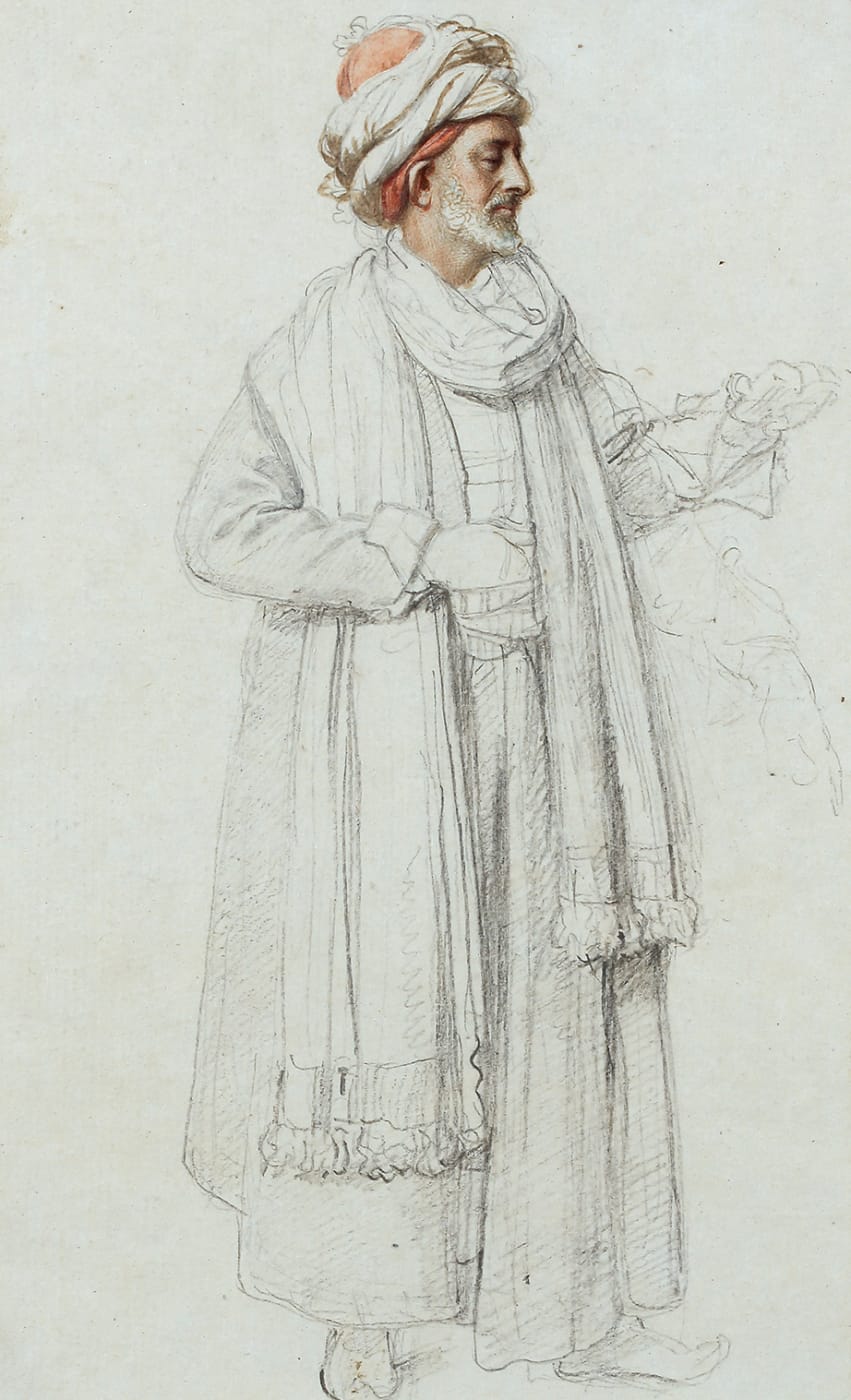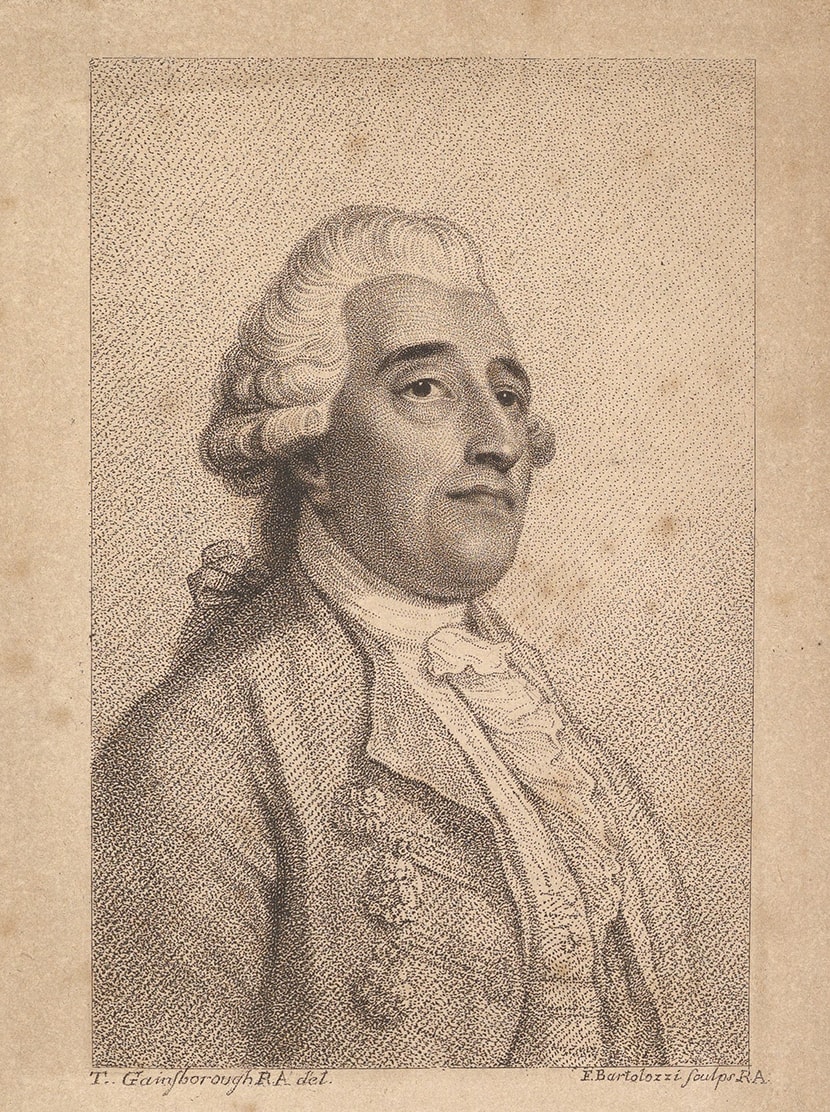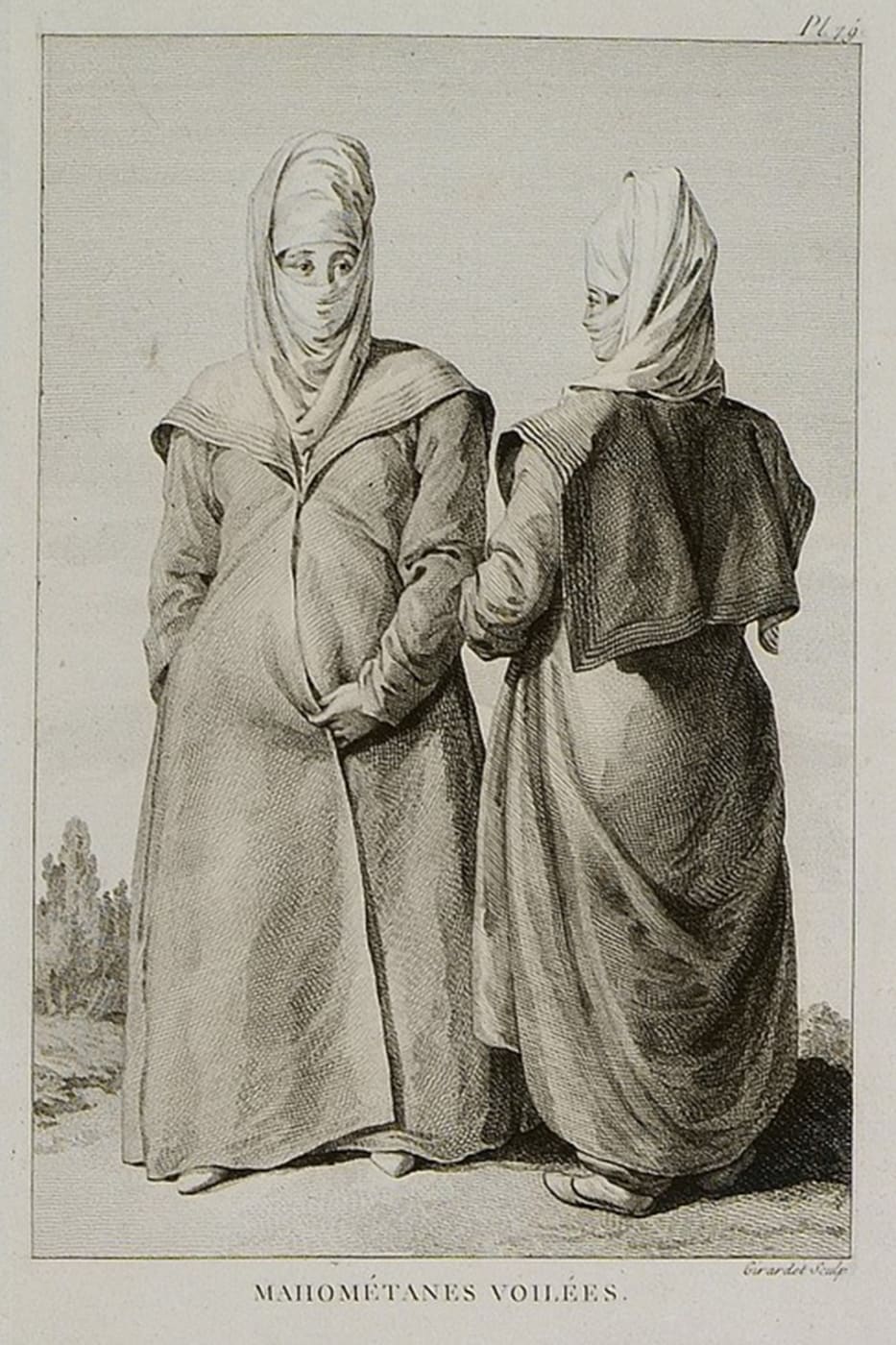Cosway's Turks
by Valeria Vallucci
This exquisite pair of pencil and watercolour drawings arrived at the gallery with no identification for the sitters. As Cosway portraits of sitters in oriental dress are extremely rare, we scanned his letters, engravings and lists of portraits for any indication of this unusual subject. With the male figure meticulously drawn from life, caught in a pose which suggests he was unaware of the artist's presence, it seemed clear that this was someone who Cosway had met - but who?[1]
The drawings are early examples of so-called British Orientalist Portraiture and reflect a growing interest in the Muslim Mediterranean. Before artists traveled to the Ottoman Empire, depictions of so-called oriental costumes were inspired by Rubens, Rembrandt, and printed sources. Richard Cosway’s artistic nature and interest in fashion went far beyond his painted works – known (and often ridiculed) for his original dress, he was called a ‘macaroni’ or ‘dandy’. His extensive personal collection of Old Master drawings also included valuable books on costume and theatrical designs.[2]
Initially, without a name for the sitter in this intriguing drawing, we looked closely at his costume for clues. The attire of the gentleman identified him as a scholar or high-ranking secretary in North Africa:[3]
Cosway’s North African is delicate and carefully observed. Unlike costume tableaux or drawing exercises of the time, he is by no means a stereotype. His closed eyes reveal character, his cheeks sag. The impeccable brush work on his copper skin, especially at the ear and forehead, suggest he was a real person.
Researching Maria and Richard Cosway’s entourage, we found out a Tripolitan ambassador to Great Britain called Sidi Hadji Abdurrahman Adja (1720-1792) briefly joined them. This well-travelled envoy’s age and rank perfectly fit our drawing.[4]
When Abdurrahman arrived in London in late January 1786, North African pirates had been running amok in the Mediterranean plundering ships, taking slaves and demanding huge ransoms. Tripoli was trying to improve its international reputation, but had financial problems exacerbated by an outbreak of plague.[6] Nevertheless, Abdurrahman’s mission in London proved a great success. He signed “a treaty of perpetual amity” with Britain,[7] and smoothed relations with the United States, with whom Tripoli was technically at war.[8] Foreign Ministers considered Abdurrahman “a sensible candid well-disposed Man.”[9]
His exotic allure got him noticed at such public events as the Queen and King’s birthday balls, the Mansion House Ball, the sport games in Hendon, and Guild Day in Norwich. The Kentish Gazette observed:
The most remarkable person at the ball, was the Ambassador from Tripoli, attended by his Page of Honour and Secretary; all of them were dressed in the habits of their country, and appeared much delighted and astonished at the crowd of beauties that surrounded them; nor were they less object of wonder to our fair countrywomen, who beheld with admiration the venerable beard of this great Plenipo.[10]
The young Abigail Adams was impressed by Abdurrahman’s appearance which attracted “the eyes of all the Ladies.”[11] His urbanity was admired in the best London salons, and his lavish gifts made a great impression. These included a “very rich and curiously wrought saddle, holsters, and bridle”; “solid gold” stirrups; and luxurious robes.[12] He gave a dress to one of Maria Cosway’s “most intimate friends”[13], the socialite Lady Caroline Ailesbury (1723-1801).[14] Both ladies moved in the highest artistic and theatrical circles of Georgian society.
It is in this context of excitement the Cosways must have welcomed Adburrahman to their fashionable salon at Schomberg House. The magnetically charming, half-Italian Maria (“The Goddess of Pall Mall”) was famous for making friends, winning hearts and enchanting guests with her singing and harp-playing,[15] while her husband, recently appointed Primarious Pictor to the Prince of Wales, painted or sketched their visitors. Maria’s Sunday evening concerts drew a particularly international crowd. Horace Walpole was a regular visitor, as were representatives of foreign countries like Corsican patriot Pasquale Paoli (1725-1807) and Francesco Maria D’Ageno (1727-1788) of Genoa.[16] The engraver Francesco Bartolozzi (1727-1815) and the castrati Giusto Ferdinando Tenducci (1735 -1790) and Giovanni Maria Rubinelli (1753-1829) rotated around Cosways’ circle.[17] They were all admirers of Maria’s talents, but also felt comfortable in her company, as she spoke Italian.[18] Abdurrahman, whose lingua franca was Italian, certainly felt the same way.
We believe it was in this inspiring context that Cosway casually – but sensitively – drew his likeness of Abdurrahman. The picture was not commissioned, and it stayed with the artist until his death.
Evidence that Abdurrahman was part of this society emerges from a collection of letters addressed to a “Mrs C.” (Maria Cosway) by the Genoese envoy Francesco D’Ageno. In one letter, D’Ageno describes the journey to Abdurrahman’s magnificent abode in the English countryside, where he acted as his interpreter. The story is told as if it was an Oriental tale of a visit to a Muslim land. The conversation naturally turns to Maria. Abdurrahman apparently said: “Mi veder quella Uri con tanto piacer” (I would love to see that Houri).[19] But D’Ageno was probably joking. Another humorous letter has Abdurrahman supposedly asking for permission to throw himself at Maria’s feet and offering her a “Numedian Tyger” in exchange for “a printed image” of her. [20] The letter is clearly part of an ‘in-joke’ with Maria and hints again at the friendship that surely inspired our pair of Cosway drawings.
By contrast, we believe Two Veiled Young Women is based on memories of printed costume sources. The costume is much harder to identify. It is certainly not typical Northern African dress. The robes suggest Ottoman attire, while the exaggerated head covering could be Greek or north European.[21] If there is a connection between the drawings of Abdurrahman and the two women, it is to be found in that important literary source of British Romantic Orientalism, Narrative of Ten Years’ Residence at Tripoli in Africa: from the original correspondence in possession of the family of the late Richard Tully.[22]
This collection tells us that after becoming a widower, Abdurrahman visited Alexandria to find Greek wives for himself and his nephew Siddi Mustapha. Having bought two “equally handsome” Christian Greek sisters at a slave market, he chose one, Lilla Amnani, for himself. Lilla Amnani was a “Grecian beauty” of seventeen, skillful in drawing, singing, and playing music. She was described as “sensible and amiable, of a very fine figure, tall, with blue eyes and beautiful small white teeth”. Back in Tripoli, she converts to Islam, and becomes the mother of Abdurrahman’s children. While he was in London from June 1785 to May 1787, Lilla gained unlimited power over his family and property.[23] The intriguing story of Lilla Amnani and her sister, from the slave market to ruling Tripolitan household, caught the British literary imagination.[24]
Neither sister accompanied Abdurrahman to London, but Siddi Mustapha did. It is possible that Richard Cosway heard the story of the two Greek sisters and was inspired by it, especially in a diplomatic context, where the slave trade was a focus of discussion.
The beautifully-drawn large eyes of the young veiled woman complement the meditative eyes of Abdurrahman. The movement of her long veil, and the turn of her head beautifully counterpoint his self-control and magnanimity. These unfinished Turks pictures delineate an imaginary space where clothing, skin colour, and status might inspire interest in the Oriental. But this pales beside the profound nobility of their gestures. Above all, these drawings delicately express an amicable encounter between East and West with no suggestion of a diplomatic struggle or cultural appropriation.
____________________________________
[1] My thanks to Emma Rutherford for first introducing me to the subject and cataloguing these drawings.
[2] Cosway owned copies of Wenceslaus Hollar’s Ornatus muliebris Anglicanus or The severall habits of English women, from the nobilitie: to the country woman, as they are in these times, A sett of the dresses & habits of foreign ladies & women (1640); Jacques Le Hay’s Recueil de Cent Estampes representant différentes Nations du Levant (1714); Thomas Jeffersey’s A Collection of the Dresses of Different Nations (1757-72); and, most probably, Hans Veigel’s Habitus Praecipiorum populorum (1577) and Cesare Vecellio’s Habiti Antichi et Moderni di tutto il Mondo (1598). See LLOYD, S., Richard and Maria Cosway: Regency Artists of Taste and Fashion, National Galleries of Scotland, 1995, pp. 110-11.
[3] Telling details include the red threads in the turban cloth, the striped belt, and the style of his waistcoat and caftan. Compare, for instance, to Wilhelmine Schwanck’s The Scholar (1876) (https://www.bonhams.com/auctio ns/26561/lot/22/?category=list&length=12&page=2), and to Labrousse’s Homme des Etats Barbaresques (1796). For a description of the typical costumes of “the better class of Tripolines”, see CAPTAIN LYON, G.F., A Narrative of Travels in Northern Africa, in the years 1818, 19, and 20, Darfs Publishers, London, 1958, pp. 5-7.
[4] For ease, we will call him Abdurrahman, but his name has been transcribed in innumerable ways: Chagì Abdurahman Agà; Sidi Haji Abdul Rahman Adja; Siddi; Sidi Hadji Abdurrahman Adja; Sidi Haggi ‘Abd-ur-rahman Aga; Sidi Haji Abdrahaman; Hadgi Abderrahman; Abdrahaman; Hadj Abderrahmane Agha; Hajee Aga; Hajee Abdrahaman Aga; ʿAbd al-Raḥmān Aġa; Abder Achman Aga; al-Sayyid al-Ḥāǧǧ ʿAbd al-Raḥmān Aġa; and Hāğğ ‘Abd ar-Rahmān Aghā.
[5] PALLUCCHINI, R., ed., La pittura nel Veneto. Il Settecento, vol. II, Milano, 1995, p. 440. An etching of the same portrait by the same artist belongs to the Royal Collection Trust
[6] Tripoli was part of the Ottoman Empire, but its Regency, under the Karamanli dynasty, had won political and commercial independence from the Port. See FENDRI, M., ‘John Adams et Hadj Abderrahmane Agha: Négociations de paix américano-tripolitaines précoces (Londres, 1786)’, in Hespéris-Tamuda LV (1), 2020, p. 281.
For an overview of the Tripolitan embassy, see LEFEVBRE, C., “The Life of a Text: Carsten Niebuhr and ʿAbd al-Raḥmān Aġa’s Das Innere Von Africa, in Landscapes, Sources, and Intellectual Projects of the West African Past, ed. by T. Green and B. Rossi, Brill, Leiden, 2018, pp. 379-99.
[7] Bury and Norwich Post, 08 February 1786, p. 1.
[8] When Abdurrahman met with John Adams and Thomas Jefferson in March 1786, he expressed his “abhorrence of the cruel custom of making slaves of their prisoners” and proposed a “speedy settlement with America” – contingent upon the US acknowledging Tripoli power and paying $100,000 annual tribute. See The Adams Papers Digital Edition (16/02/1786; 08/04/1786). Despite his difficult requests, the Tripolitan ambassador made a good impression as a capable and rational diplomat.
[9] The Adams Papers Digital Edition (09/02/1786; 21/02/1786; 22/07/1786).
[10] Northampton Mercury, 11 February 1786, p. 3.
[11] The Adams Papers Digital Edition (21/02/1786; 22/07/1786).
[12] Norfolk Chronicle, 04 February 1786, p. 1.
[13] WILLIAMSON, G.C., Richard Cosway R.A., Bell & Sons, London, 1905, p. 13.
[14] Narrative of Ten Years’ Residence at Tripoli in Africa: from the original correspondence in possession of the family of the late Richard Tully, esq, Henry Colburn, London, 1817, p. 153.
[15] The Graphic, 13 February 1892, p. 21.
[16] BERRETTI, F., ed., Pascal Paoli à Maria Cosway. Lettres et Documents, 1782-1803, Voltaire Foundation, Oxford, 2003, p. 34.
[17] BRUMANA, B., “Francesco Bartolozzi (1728-1815) incisore della musica” in Esercizi. Musica e Spettacolo (20, nuova serie 11, 2006-2007), Morlacchi Editore, Perugia, 2008, p. 46.
[18] BERRETTI, F., ed., Pascal Paoli à Maria Cosway. Lettres et Documents, 1782-1803, Voltaire Foundation, Oxford, 2003, p. 34.
[19] TONIOLI, G., Prose e Rime del Signor Francesco d’Ageno, Dennett, Londra, 1790, p. 37.
[20] TONIOLI, ibid., pp. 81-82.
[21] Compare with https://eng.travelogues.gr/item.php?view=53795; https://digitalcollections.nypl.org/items/510d47e3-b00c-a3d9-e040-e00a18064a99; and https://damesalamode.tumblr.com/image/5867239458.
[22] This book was written by English Consul Richard Tully’s sister-in-law, who accompanied him to Tripoli in 1783, just after Abdurrahman was named ambassador to England. Tully’s and Abdurrahman’s families became close, so Narrative is full of interesting anecdotes about the ambassador’s private life.
[23] Narrative of Ten Years’ Residence at Tripoli in Africa: from the original correspondence in possession of the family of the late Richard Tully, esq, Henry Colburn, London, 1817, pp. 53-60; 109-14.
[24] For instance, Henrietta E. Harrison published a poem entitled Georgian Sisters in Findens’ Tableaux (1838), together with a stipple engraving by H. Egleton, after T. Uwins’s painting The Slave Merchant. Lilla Amnani is also the main character in Elizabeth Thomas’s The Georgian; Or, the Moor of Tripoli (1847).












